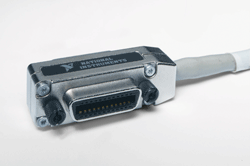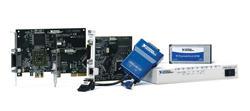Rumors of the death of the bus defined by the IEEE-488 specification decades ago are greatly exaggerated
BY MURALI RAVINDRAN
National Instruments
Austin, TX
http://www.ni.com
From time to time, you probably wonder how you will communicate with your test and measurement equipment in the future. Will you be able to connect to your GPIB instrument? Will LXI replace GPIB? Will Hi-Speed USB offer better performance and faster setup time than LXI? What new instrument control interfaces will emerge? These are all critical questions for today’s engineers and scientists.

Fig. 1. GPIB remains the de facto standard today for instrument control.
A workhorse
Many instrument control bus technologies with varying bus speeds, latency, connectors, cabling, and prices have come and gone over the years. GPIB, however, has remained a de facto standard for PC-based control of stand-alone instruments and will continue to be used in test and measurement systems for many years to come.
When asked why they use GPIB for instrument control, the top response from engineers and scientists is “It just works.” In the engineering world of unknowns, it is reassuring to know you can count on your GPIB-based systems to function properly.
Despite the emergence every few years of new bus technologies for instrument control, GPIB remains the foundation for such systems and serves as a critical bridging technology in applications using multiple instrument control bus options.
Many companies contributed to the creation of the parallel bus structure that became known as GPIB, driving the introduction of the ANSI/IEEE-488 standard, so engineers and scientists could control their instruments from desktop PCs regardless of vendor. Since the early days of GPIB, NI has actively advanced the standard and its technologies, gathering feedback from users and instrument vendors for all components required to use the bus from integrated circuits and interface cards for multiple OS platforms to software firmware and application programming interfaces (APIs). These collaborative efforts over the past 30 years have helped GPIB become a proven, easy-to-use control interface with the following benefits:
Thousands of GPIB instruments.Software compatibility with other instrument interfaces (enabled by NI-VISA and SCPI).Proven ease of use and familiarity.Low-latency performance (30 µs).Good bandwidth performance (up to 8 Mbytes/s using the high-speed version, HS488).Extremely rugged cabling and connectors.Long distances via fiber-optic and Ethernet extenders.
Due to continuous adoption of GPIB, during the past five years NI has redesigned many GPIB products to include new features, reduce physical size, and enhance capabilities. Some of these GPIB products and research areas include the following:
Introduction of the first PCI Express GPIB controller.Hi-Speed USB-to-GPIB high-speed controller.RoHS-compliant controllers, cables, and integrated circuits.Compatibility with Windows Vista, Mac OS X, and Solaris 9 and 10.
No wonder, then, that in the first quarter of 2008, more than 80% of new instruments publicly announced by leading test and measurement companies incorporated GPIB.
The success of GPIB and its continued use is largely related to ubiquitous software and instrument driver availability. NI itself develops new instrument drivers for instruments released by hundreds of different vendors. Today, the NI Instrument Driver Network (www.ni.com/idnet) offers more than 6,100 instrument drivers, and nearly 100 new drivers have been added in the past three months.
Continued GPIB device driver development and frequent OS support updates help ensure success using GPIB with any OS and development language you choose.

Fig. 2. Even in card-based instrument systems, GPIB continues to be a reliable option for instrument control.
New control technologies
Despite the use of GPIB in the industry as a de facto instrument control bus interface, it is important to remember that no single bus or technology has been able to deliver the best performance, simplest ease of use, and lowest cost. GPIB demonstrates the best combination of these elements, but it is not the best in all categories. Thus, you should understand the specific instrument control needs of your application before choosing an instrument control bus.

In evaluating new instrument control technologies, it is apparent that there are three new promising instrument control bus technologies: USB, Ethernet/LXI, and Cabled PCI Express. USB-controlled devices are well-suited for applications with portable measurements, laptop or desktop data logging, and in-vehicle data acquisition; however, the cable length is limited to 5 m and the connectors are not rugged.
Ethernet/LXI is most useful for creating a network of highly distributed instruments that require remote access capabilities across large geographies. But Ethernet/LXI has the highest (worst) latency of all instrument control bus interfaces. This can cause significant bottlenecks in high-performance applications.
Cabled PCI Express is an emerging technology that holds promise for a high-bandwidth, low-latency interface for instrument control, but it requires controller and cables, like GPIB. So GPIB will continue meeting most engineers’ measurement and automation needs for years to come. ■
Advertisement
Learn more about National Instruments





